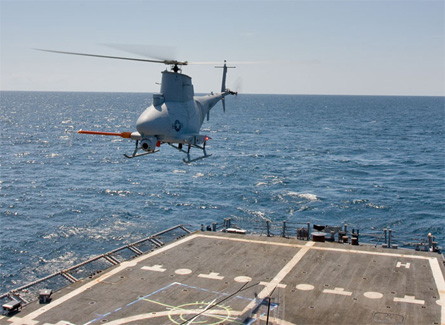It has been a turbulent time lately for manufacturers of vertical take-off unmanned air vehicles, which can be excused some confusion after the behaviour demonstrated by the world's largest defence market.
The US Coast Guard planned, and then cancelled, a buy of Bell Eagle Eye tiltrotor UAVs for its troubled Deepwater overhaul. The US Navy first purchased, then cancelled, then repurchased Northrop Grumman's RQ/MQ-8 Fire Scout. The US Army did much the same when it cancelled the future combat systems programme; as recently as last year the service declared the VTUAV dead, and began looking at optionally manned Sikorsky UH-60 Black Hawks, only to restate its interest this year.
The cancellation of another major programme the VTUAV was designed to fulfil, from the navy's littoral combat ship, also did little to help reassure manufacturers.
However, after these periods of uncertainty, the future for VTUAVs appears a little more secure. After criticism over its lacklustre performance, the MQ-8B, based on the Schweizer 333, is being superseded by a C model that migrates the same software and sensors to a Bell 407 airframe and will deliver vastly improved capability.
 |
|---|
© Northrop GrummanThe US Navy first purchased, then cancelled, then repurchased Northrop Grumman's RQ/MQ-8 Fire Scout |
At the same time, the MQ-8B is on a combat deployment on the USS McInerny, hunting pirates off the Somali coast. The navy last week announced the deployment of MQ-8Bs from its NAS Patuxent River test facility in Maryland directly into a combat zone in northern Afghanistan, fulfilling what it calls an "urgent operational need".
The future of the Boeing A160 Hummingbird had been called into question when one rolled over during testing in Belize, leading to the grounding of the rest of the test fleet pending the outcome of an investigation.
However, Boeing is now preparing to deploy the helicopter with three different services: to Afghanistan for the US Defense Advanced Research Projects Agency, where it will carry the Argus-IS wide-aperture camera; to an undisclosed location for the US Special Operations Command carrying the Forester radar; and a potential third to Afghanistan for the US Marine Corps to demonstrate resupply capabilities.
"We think there is a huge requirement in the customer's mind for vertical unmanned for two missions," Boeing Military Aircraft president Christopher Chadwick said earlier this month at a briefing in St Louis, Missouri. "One is to get capability resources that last mile, where other platforms can't, and the other [is to] provide a unique ISR [intelligence, surveillance and reconnaissance] capability because it can loiter."
Foreign manufacturers are also plunging into the fray: Austrian manufacturer Schiebel has sold its S-100 Camcopter to several countries, including Germany and the United Arab Emirates, and Swedish manufacturer Saab is marketing its Skeldar UAV.
These programmes represent a maturing of the VTUAV concept. No longer is it sufficient to simply modify existing manned airframes. In their place come purpose-built, long-endurance, mission-based platforms.
In addition, the rotary VTUAV concept that once appeared dormant is gaining credibility. The first generation is now on trial, the second generation will be more capable, more widespread, more effective, and better employed.
Fixed-wing UAVs have been prominent in conflicts for two decades, leading to innovative new tactics and driving new sets of requirements for unmanned vehicles that have changed the face and practice of warfare.
The first generation of operational rotary-wing VTUAVs could become another game-changer for tactical operations, potentially granting the user a number of important attributes: the ability to sit nearby and observe for days at a time, or as a pinch-hit communications node, or to drop supplies in denied territory.
The process is still edging along in fits and starts. The army, interested in the capabilities if not always a reliable customer, has yet to define requirements for a potential purchase, although a draft request for proposals is on the horizon.
Even as the first generation of rotary VTUAVs undergoes real-world testing, the next generation is beginning to take shape. Northrop in 2009 presented an unmanned vehicle concept called Wild Thing, a fan-in-wing cargo-mover that has undergone windtunnel testing. Urban Aeronautics of Israel's unconventional Mule design remains a competitor.
Boeing and Northrop have each made significant developments of VTUAVs off their own bat, testing modifications not yet requested to fit requirements not yet developed. And the strategy seems to be paying off.
The contest to watch is the navy's medium-range maritime unmanned air system competition, funded in fiscal year 2012. It is planned to select two competitors to build prototypes in early 2013. Northrop has announced it will offer the MQ-8C; Boeing is likely to offer the A160, and there are sure to be other manufacturers with similar bids.
Although rotary-wing UAVs are only just entering operations, the experience gained here is sure to result in a flurry of new designs and performance tweaks, likely to match the rate of development of their fixed-wing cousins.
Source: Flight International























